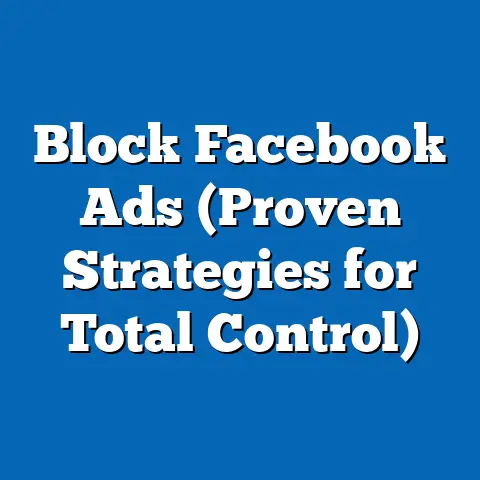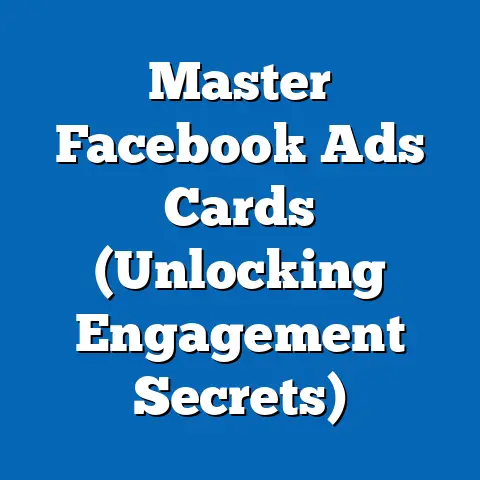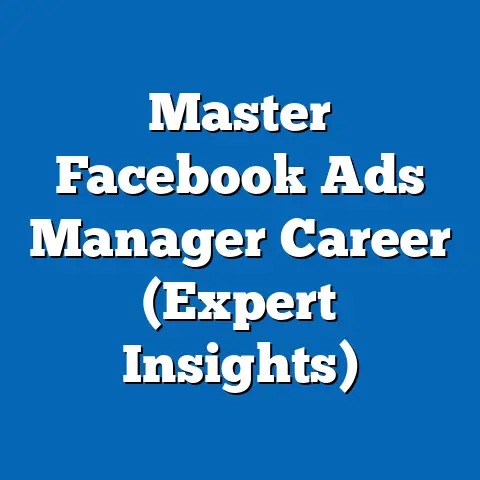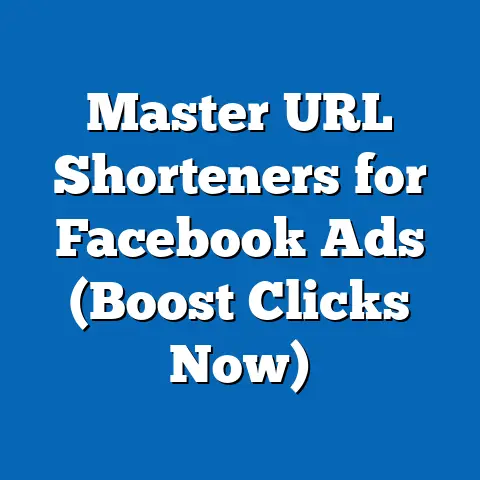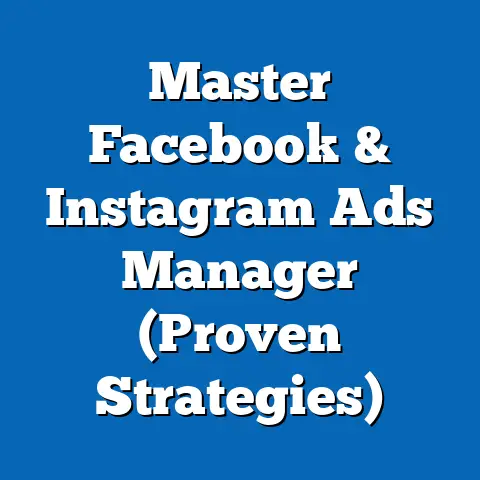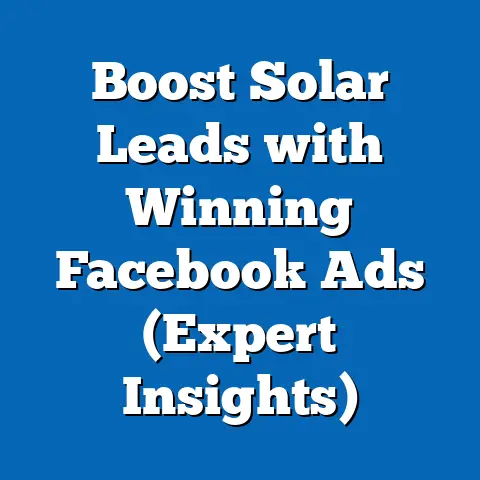Transform Facebook Sale Ads for Maximum Impact (Pro Tips)
Transform Facebook Sale Ads for Maximum Impact: Pro Tips to Skyrocket Your Sales
Ever feel like you’re throwing money into a black hole with your Facebook ads? You meticulously craft your copy, painstakingly select your visuals, and carefully target your audience, only to be met with disappointing results. It’s frustrating, I know. I’ve been there. I remember one particular campaign I ran for a local bakery. We had beautiful photos of their pastries, a catchy headline, and what I thought was a laser-focused audience. Crickets. Turns out, we were missing a crucial ingredient: a clear understanding of what truly motivates people to click and buy on Facebook.
What if I told you there are secrets, hidden strategies, that successful brands use to turn their Facebook ads into powerful sales tools? What if you could unlock the potential of your ads and finally see the ROI you deserve? What secrets do successful brands know that you don’t?
This isn’t just about boosting posts and hoping for the best. It’s about understanding the psychology of your audience, crafting compelling stories, and using Facebook’s advanced targeting options to connect with the right people at the right time. It’s about transforming your ads from mere advertisements into irresistible offers that drive sales.
In this guide, I’ll walk you through everything you need to know to transform your Facebook sale ads for maximum impact. We’ll cover everything from understanding the Facebook ad ecosystem to crafting compelling ad copy, choosing visuals that sell, and leveraging advanced targeting strategies. By the end of this article, you’ll have the knowledge and tools you need to skyrocket your sales and achieve your advertising goals.
Section 1: Understanding the Facebook Ad Ecosystem
Before we jump into the nitty-gritty details of crafting high-converting ads, it’s crucial to understand the current landscape of Facebook advertising. It’s not enough to simply create an ad and hope it performs well. You need to understand how Facebook’s algorithm works, how users behave on the platform, and how your ads fit into the overall ecosystem.
The Relevance of Facebook Advertising Today
Despite the rise of newer social media platforms, Facebook remains a dominant force in the digital marketing world. With billions of active users worldwide, Facebook offers unparalleled reach and targeting capabilities. According to Statista, as of Q1 2024, Facebook boasts nearly 3.1 billion monthly active users. That’s a massive audience you simply can’t ignore.
But it’s not just about the sheer number of users. Facebook also offers incredibly granular targeting options, allowing you to reach specific demographics, interests, and behaviors. This means you can target your ads to the people who are most likely to be interested in your products or services, maximizing your chances of success.
Furthermore, Facebook’s advertising platform is constantly evolving, with new features and tools being added regularly. This means you need to stay up-to-date with the latest trends and best practices to ensure your ads remain effective.
How Facebook’s Algorithm Works and the Importance of Audience Targeting
Facebook’s algorithm, often referred to as “EdgeRank,” determines which content users see in their newsfeeds. While the exact details of the algorithm are a closely guarded secret, we know that it takes into account factors such as:
- Relevance: How relevant is the content to the user’s interests?
- Engagement: How much engagement (likes, comments, shares) is the content receiving?
- Timeliness: How recently was the content posted?
- Relationship: How often does the user interact with the content creator?
For ads, this means that Facebook prioritizes ads that are relevant to the user and likely to generate engagement. This is where audience targeting comes in. By targeting your ads to the right audience, you increase the chances that your ads will be seen by people who are interested in your products or services. This, in turn, leads to higher engagement and better ad performance.
I remember when Facebook first rolled out its detailed targeting options. I was initially overwhelmed by the sheer number of choices. But as I experimented with different targeting parameters, I began to see the power of this feature. I was able to target ads to specific demographics, interests, and behaviors, resulting in significantly higher click-through rates and conversion rates.
Understanding User Behavior on the Platform
To create effective Facebook ads, you need to understand how users behave on the platform. People use Facebook for a variety of reasons, including:
- Connecting with friends and family: This is the primary reason why most people use Facebook.
- Staying up-to-date with news and events: Many people use Facebook to get their daily dose of news and information.
- Entertainment: Facebook is a popular platform for watching videos, playing games, and browsing memes.
- Discovering new products and services: Many people use Facebook to find new products and services that they might be interested in.
When creating your ads, it’s important to keep these motivations in mind. Your ads should be engaging, informative, and relevant to the user’s interests. You should also avoid being too pushy or salesy, as this can turn people off.
Think about the last time you were scrolling through Facebook. What caught your eye? What made you stop and click on an ad? Chances are, it was an ad that was visually appealing, relevant to your interests, and offered something of value.
Key Takeaway: Understanding the Facebook ad ecosystem, including the algorithm, audience targeting, and user behavior, is crucial for creating effective ads that drive sales.
Section 2: Crafting Compelling Ad Copy
The ad copy is the heart and soul of your Facebook ad. It’s what grabs the user’s attention, communicates your message, and persuades them to take action. Crafting compelling ad copy is an art, and it requires a deep understanding of your target audience and their motivations.
The Art of Persuasive Writing for Facebook Ads
Persuasive writing is all about understanding your audience and crafting a message that resonates with them. It’s about identifying their pain points, highlighting the benefits of your product or service, and creating a sense of urgency.
Here are some key principles of persuasive writing for Facebook ads:
- Know your audience: Before you start writing, take the time to understand your target audience. What are their demographics, interests, and behaviors? What are their pain points and motivations?
- Highlight the benefits: Focus on the benefits of your product or service, rather than just the features. How will your product or service make their lives better?
- Create a sense of urgency: Use language that creates a sense of urgency, such as “Limited time offer” or “Shop now before it’s too late.”
- Use strong verbs and adjectives: Use strong verbs and adjectives to make your copy more engaging and persuasive.
- Keep it concise: Facebook ads have limited space, so it’s important to keep your copy concise and to the point.
I remember working with a client who sold organic skincare products. Their initial ad copy focused on the ingredients of their products. While this information was important, it wasn’t resonating with their target audience. After doing some research, we discovered that their target audience was primarily concerned with reducing wrinkles and improving their skin’s overall appearance. We rewrote the ad copy to focus on these benefits, and we saw a significant increase in click-through rates and conversion rates.
Attention-Grabbing Headlines and Engaging Descriptions
Your headline is the first thing people see when they encounter your ad, so it’s crucial to make it attention-grabbing. Your headline should be clear, concise, and relevant to your target audience. It should also pique their curiosity and make them want to learn more.
Your description should expand on your headline and provide more details about your product or service. It should also highlight the benefits of your product or service and include a clear call-to-action.
Here are some tips for writing attention-grabbing headlines and engaging descriptions:
- Use numbers and statistics: Numbers and statistics can be very effective at grabbing attention. For example, “5 Ways to Improve Your Skin in Just One Week.”
- Ask a question: Asking a question can pique the reader’s curiosity and make them want to learn more. For example, “Are You Tired of Looking Tired?”
- Use power words: Power words are words that evoke emotion and make your copy more persuasive. Some examples of power words include “Free,” “New,” “Easy,” and “Guaranteed.”
- Tell a story: Telling a story can be a great way to engage your audience and make your copy more memorable.
- Use humor: Humor can be a great way to grab attention and make your copy more relatable. However, it’s important to use humor appropriately and avoid being offensive.
The Importance of a Clear Call-to-Action (CTA)
Your call-to-action (CTA) is the most important part of your ad copy. It’s what tells the user what you want them to do. Your CTA should be clear, concise, and action-oriented. It should also be relevant to your offer and your target audience.
Here are some examples of effective CTAs:
- Shop Now
- Learn More
- Sign Up
- Get Started
- Download Now
It’s important to test different CTAs to see which ones perform best with your target audience. You can use Facebook’s A/B testing feature to test different CTAs and see which ones generate the most clicks and conversions.
Examples of Successful Ad Copy
To illustrate these points, let’s take a look at some examples of successful ad copy from various industries:
- Example 1: E-commerce (Clothing)
- Headline: “New Arrivals: Shop the Latest Spring Styles”
- Description: “Freshen up your wardrobe with our new collection of spring styles. Shop now and get 20% off your first order!”
- CTA: Shop Now
- Example 2: SaaS (Software as a Service)
- Headline: “Boost Your Productivity with Our Powerful Software”
- Description: “Our software helps you streamline your workflow and get more done in less time. Sign up for a free trial today!”
- CTA: Sign Up
- Example 3: Local Business (Restaurant)
- Headline: “Craving Delicious Pizza? Order Now!”
- Description: “Enjoy a hot and delicious pizza delivered right to your door. Order now and get a free side of garlic bread!”
- CTA: Order Now
- Headline: “New Arrivals: Shop the Latest Spring Styles”
- Description: “Freshen up your wardrobe with our new collection of spring styles. Shop now and get 20% off your first order!”
- CTA: Shop Now
- Headline: “Boost Your Productivity with Our Powerful Software”
- Description: “Our software helps you streamline your workflow and get more done in less time. Sign up for a free trial today!”
- CTA: Sign Up
- Headline: “Craving Delicious Pizza? Order Now!”
- Description: “Enjoy a hot and delicious pizza delivered right to your door. Order now and get a free side of garlic bread!”
- CTA: Order Now
Notice how each of these examples uses attention-grabbing headlines, engaging descriptions, and clear calls-to-action. They also highlight the benefits of the product or service and create a sense of urgency.
Key Takeaway: Crafting compelling ad copy is essential for driving clicks and conversions. Focus on understanding your audience, highlighting the benefits of your product or service, and using a clear call-to-action.
Section 3: Visuals That Sell
In the visually-driven world of social media, your ad’s visuals are often the first thing that captures a user’s attention. A compelling image or video can be the difference between someone scrolling past your ad and stopping to learn more.
The Role of Visuals in Facebook Ads
Visuals play a crucial role in Facebook ads for several reasons:
- Grab Attention: In a crowded newsfeed, a striking visual can immediately grab a user’s attention and make them stop scrolling.
- Communicate Your Message: Visuals can communicate your message quickly and effectively, even without the user reading your ad copy.
- Create Emotion: Visuals can evoke emotion and make your ad more memorable.
- Showcase Your Product: Visuals can showcase your product or service in action, helping users visualize how it can benefit them.
I’ve seen firsthand how the right visual can dramatically improve ad performance. I once worked with a real estate agent who was struggling to generate leads with their Facebook ads. Their initial ads featured generic photos of houses. We decided to try something different and used high-quality photos of the interiors of the houses, showcasing their beautiful design and features. We also included a video tour of one of the houses. The results were astounding. We saw a significant increase in click-through rates and lead generation.
Choosing the Right Images or Videos
Choosing the right images or videos for your Facebook ads is crucial. Your visuals should be:
- High Quality: Use high-resolution images and videos that are clear, crisp, and visually appealing.
- Relevant: Your visuals should be relevant to your product or service and your target audience.
- Eye-Catching: Use visuals that are eye-catching and stand out in the newsfeed.
- Brand-Aligned: Your visuals should be consistent with your brand’s overall aesthetic and messaging.
Here are some tips for choosing the right images or videos:
- Use professional photos: If possible, hire a professional photographer or videographer to create high-quality visuals for your ads.
- Use stock photos: If you can’t afford professional photos, use high-quality stock photos from reputable sources.
- Use videos: Videos are a great way to engage your audience and showcase your product or service in action.
- Use user-generated content: User-generated content (UGC) can be a great way to build trust and credibility.
- Test different visuals: Use Facebook’s A/B testing feature to test different visuals and see which ones perform best with your target audience.
A/B Testing Different Visuals
A/B testing is a powerful tool for optimizing your Facebook ads. It allows you to test different versions of your ad and see which one performs best. When it comes to visuals, A/B testing can help you determine which images or videos resonate most with your target audience.
Here are some things you can test when A/B testing visuals:
- Different images: Test different images of the same product or service.
- Different videos: Test different videos of the same product or service.
- Different angles: Test different angles of the same product or service.
- Different compositions: Test different compositions of the same product or service.
- Different colors: Test different colors in your visuals.
By A/B testing different visuals, you can gain valuable insights into what resonates with your target audience and optimize your ads for maximum impact.
Key Takeaway: Visuals play a crucial role in Facebook ads. Choose high-quality, relevant, and eye-catching images and videos that align with your brand. Use A/B testing to determine which visuals resonate most with your target audience.
Section 4: Targeting the Right Audience
Even the most compelling ad copy and stunning visuals will fall flat if they’re not seen by the right people. That’s why targeting the right audience is essential for Facebook ad success. Facebook offers a wide range of targeting options, allowing you to reach specific demographics, interests, behaviors, and custom audiences.
Different Targeting Options Available on Facebook
Facebook offers a variety of targeting options, including:
- Demographics: Target users based on their age, gender, education, relationship status, and location.
- Interests: Target users based on their interests, hobbies, and activities.
- Behaviors: Target users based on their purchase behaviors, travel habits, and device usage.
- Custom Audiences: Target users based on your own data, such as email lists, website visitors, and app users.
- Lookalike Audiences: Target users who are similar to your existing customers or website visitors.
Each of these targeting options offers unique advantages. Demographics are useful for targeting broad audiences, while interests and behaviors are useful for targeting more specific audiences. Custom audiences are useful for retargeting existing customers or website visitors, and lookalike audiences are useful for expanding your reach to new customers who are similar to your existing ones.
I remember when I first started using Facebook ads, I relied heavily on demographic targeting. I would target users based on their age, gender, and location. While this approach was somewhat effective, I wasn’t seeing the results I wanted. It wasn’t until I started experimenting with interest-based targeting and custom audiences that I really started to see a significant improvement in my ad performance.
Creating Audience Personas
To refine your targeting strategies, it’s helpful to create audience personas. An audience persona is a fictional representation of your ideal customer. It’s based on research and data about your existing customers and target audience.
When creating an audience persona, consider the following factors:
- Demographics: Age, gender, location, education, income, etc.
- Interests: Hobbies, activities, passions, etc.
- Behaviors: Purchase habits, online behavior, device usage, etc.
- Pain Points: What problems or challenges are they facing?
- Goals: What are they trying to achieve?
- Motivations: What motivates them to buy your product or service?
By creating audience personas, you can gain a deeper understanding of your target audience and tailor your ads to their specific needs and interests.
Retargeting for Maximum Ad Effectiveness
Retargeting is a powerful strategy for maximizing ad effectiveness. It involves targeting users who have already interacted with your business, such as website visitors, app users, or email subscribers.
Retargeting works by placing a pixel on your website or app. This pixel tracks the behavior of users who visit your website or app. You can then use this data to create custom audiences and target ads to these users.
Retargeting is effective because it allows you to reach users who are already familiar with your brand and interested in your products or services. It also allows you to tailor your ads to their specific behavior. For example, you can target ads to users who have abandoned their shopping carts or viewed specific products on your website.
Key Takeaway: Targeting the right audience is essential for Facebook ad success. Use a combination of demographic, interest-based, behavioral, custom, and lookalike audiences to reach your ideal customers. Create audience personas to refine your targeting strategies and leverage retargeting for maximum ad effectiveness.
Section 5: Leveraging Facebook Ad Formats
Facebook offers a variety of ad formats, each with its own unique advantages. Choosing the right ad format can significantly enhance engagement and sales.
Various Facebook Ad Formats and Their Unique Advantages
Here are some of the most popular Facebook ad formats:
- Image Ads: Simple and effective for showcasing a single product or service.
- Video Ads: Engaging and immersive for telling stories and demonstrating product features.
- Carousel Ads: Allow users to scroll through multiple images or videos in a single ad.
- Slideshow Ads: Create a video-like experience using static images.
- Collection Ads: Showcase multiple products in a visually appealing format.
- Instant Experience Ads: Full-screen, interactive ads that load quickly on mobile devices.
- Lead Ads: Collect leads directly from Facebook without sending users to your website.
Each of these ad formats has its own unique advantages. Image ads are simple and effective for showcasing a single product or service. Video ads are engaging and immersive for telling stories and demonstrating product features. Carousel ads allow users to scroll through multiple images or videos in a single ad. Slideshow ads create a video-like experience using static images. Collection ads showcase multiple products in a visually appealing format. Instant Experience ads are full-screen, interactive ads that load quickly on mobile devices. Lead ads collect leads directly from Facebook without sending users to your website.
I’ve found that carousel ads are particularly effective for e-commerce businesses. They allow you to showcase multiple products in a single ad, increasing the chances that a user will find something they’re interested in. I’ve also had success with video ads, especially for demonstrating how a product works or telling a compelling story about a brand.
When to Use Each Format
The best ad format for your business will depend on your marketing goals and audience preferences. Here are some general guidelines:
- Image Ads: Use for simple product promotions, brand awareness campaigns, and retargeting.
- Video Ads: Use for product demonstrations, storytelling, brand building, and generating leads.
- Carousel Ads: Use for showcasing multiple products, highlighting product features, and telling a story.
- Slideshow Ads: Use for creating a video-like experience on a budget, showcasing product features, and telling a story.
- Collection Ads: Use for e-commerce businesses to showcase multiple products in a visually appealing format.
- Instant Experience Ads: Use for creating immersive experiences, showcasing product features, and driving conversions.
- Lead Ads: Use for generating leads, collecting email addresses, and building your email list.
Creatively Utilizing Ad Formats
To enhance engagement and sales, it’s important to creatively utilize Facebook ad formats. Here are some tips:
- Tell a story: Use your ad to tell a compelling story about your brand or product.
- Showcase your product in action: Use videos or images to showcase your product in action.
- Highlight the benefits: Focus on the benefits of your product or service, rather than just the features.
- Use high-quality visuals: Use high-resolution images and videos that are clear, crisp, and visually appealing.
- Use a clear call-to-action: Tell users what you want them to do.
- Test different formats: Use Facebook’s A/B testing feature to test different ad formats and see which ones perform best with your target audience.
Key Takeaway: Facebook offers a variety of ad formats, each with its own unique advantages. Choose the right ad format based on your marketing goals and audience preferences. Creatively utilize ad formats to enhance engagement and sales.
Section 6: Analyzing Ad Performance
Creating a great ad is only half the battle. You also need to analyze your ad performance to see what’s working and what’s not. By monitoring key metrics, you can make data-driven decisions to optimize your campaigns and maximize your ROI.
Key Metrics to Monitor for Facebook Ad Performance
Here are some of the most important metrics to monitor for Facebook ad performance:
- Reach: The number of unique people who saw your ad.
- Impressions: The number of times your ad was displayed.
- Click-Through Rate (CTR): The percentage of people who saw your ad and clicked on it.
- Cost Per Click (CPC): The amount you pay each time someone clicks on your ad.
- Conversion Rate: The percentage of people who clicked on your ad and completed a desired action (e.g., made a purchase, signed up for a newsletter).
- Cost Per Acquisition (CPA): The amount you pay for each conversion.
- Return on Ad Spend (ROAS): The amount of revenue you generate for every dollar you spend on advertising.
Each of these metrics provides valuable insights into your ad performance. Reach and impressions tell you how many people are seeing your ad. CTR tells you how engaging your ad copy and visuals are. CPC tells you how much you’re paying for each click. Conversion rate tells you how effective your landing page is. CPA tells you how much you’re paying for each conversion. And ROAS tells you how much revenue you’re generating for every dollar you spend on advertising.
Interpreting Metrics for Data-Driven Decisions
To make data-driven decisions, you need to understand how to interpret these metrics. Here are some general guidelines:
- Low Reach: If your reach is low, try expanding your targeting or increasing your budget.
- Low CTR: If your CTR is low, try improving your ad copy and visuals.
- High CPC: If your CPC is high, try refining your targeting or improving your ad quality.
- Low Conversion Rate: If your conversion rate is low, try improving your landing page or simplifying the checkout process.
- High CPA: If your CPA is high, try improving your ad quality, refining your targeting, or improving your landing page.
- Low ROAS: If your ROAS is low, try improving your ad quality, refining your targeting, or improving your landing page.
I remember working with a client who was struggling with a low conversion rate. They were getting a lot of clicks, but very few people were actually making a purchase. After analyzing their data, we discovered that their landing page was confusing and difficult to navigate. We redesigned their landing page to make it more user-friendly, and we saw a significant increase in their conversion rate.
Adjusting Ad Strategies Based on Performance Analysis
Based on your performance analysis, you can adjust your ad strategies to improve your results. Here are some things you can adjust:
- Targeting: Refine your targeting to reach a more relevant audience.
- Ad Copy: Improve your ad copy to make it more engaging and persuasive.
- Visuals: Improve your visuals to make them more eye-catching and relevant.
- Ad Format: Test different ad formats to see which ones perform best.
- Budget: Adjust your budget to allocate more resources to your best-performing ads.
- Bidding: Adjust your bidding strategy to optimize your cost per click or cost per conversion.
- Landing Page: Improve your landing page to make it more user-friendly and persuasive.
Key Takeaway: Analyzing ad performance is crucial for optimizing your campaigns and maximizing your ROI. Monitor key metrics, interpret the data, and adjust your ad strategies accordingly.
Section 7: Advanced Strategies for Maximum Impact
Once you’ve mastered the basics of Facebook advertising, you can start exploring advanced strategies to take your campaigns to the next level.
Scaling Facebook Ad Campaigns
Scaling your Facebook ad campaigns involves increasing your budget and reach without sacrificing performance. Here are some tips for scaling your campaigns:
- Increase your budget gradually: Don’t increase your budget too quickly, as this can disrupt your ad performance.
- Expand your targeting: Gradually expand your targeting to reach new audiences.
- Use lookalike audiences: Create lookalike audiences to reach users who are similar to your existing customers.
- Automate your bidding: Use Facebook’s automated bidding options to optimize your cost per click or cost per conversion.
- Monitor your performance closely: Monitor your performance closely to ensure that your scaling efforts are not negatively impacting your results.
Seasonal Promotions and Consumer Trends
Aligning your ad strategies with seasonal promotions and consumer trends can significantly boost your sales. Here are some tips:
- Plan ahead: Plan your seasonal promotions well in advance.
- Create relevant ads: Create ads that are relevant to the season or trend.
- Use seasonal visuals: Use visuals that are appropriate for the season or trend.
- Offer seasonal discounts: Offer discounts that are relevant to the season or trend.
- Target seasonal audiences: Target audiences who are likely to be interested in seasonal promotions.
User-Generated Content and Testimonials
Leveraging user-generated content (UGC) and testimonials can build trust and credibility with your audience. Here are some tips:
- Encourage users to create content: Encourage users to create content about your product or service.
- Feature UGC in your ads: Feature UGC in your ads to build trust and credibility.
- Use testimonials in your ads: Use testimonials from satisfied customers in your ads.
- Highlight positive reviews: Highlight positive reviews of your product or service in your ads.
- Respond to negative reviews: Respond to negative reviews in a timely and professional manner.
Key Takeaway: Once you’ve mastered the basics of Facebook advertising, explore advanced strategies to take your campaigns to the next level. Scale your campaigns gradually, align your strategies with seasonal promotions and consumer trends, and leverage user-generated content and testimonials to build trust and credibility.
Conclusion
We’ve covered a lot of ground in this guide. From understanding the Facebook ad ecosystem to crafting compelling ad copy, choosing visuals that sell, targeting the right audience, leveraging different ad formats, analyzing ad performance, and exploring advanced strategies, you now have the knowledge and tools you need to transform your Facebook sale ads for maximum impact.
But remember, the key to success lies in continual learning and adaptation. The digital landscape is constantly evolving, and Facebook is always rolling out new features and tools. Stay up-to-date with the latest trends and best practices, and don’t be afraid to experiment and try new things.
I encourage you to take the tips and strategies shared in this guide and implement them in your own Facebook ad campaigns. Start small, test different approaches, and track your results. The more you experiment, the more you’ll learn about what works best for your business and your audience.
And most importantly, remember that the key to success lies in understanding your audience. The more you know about your target audience, the better you’ll be able to create ads that resonate with them and drive sales.
So go out there and transform your Facebook sale ads into powerful sales tools. With a little bit of knowledge, effort, and experimentation, you can unlock the potential of your ads and achieve your advertising goals. Good luck!

